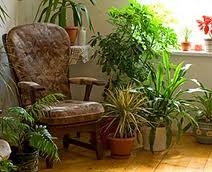
This column addresses the role of humidity and ventilation, proper feeding and pest control. For more advice, consult the University of California’s California Garden Web site (http://cagardenweb.ucanr.edu/Houseplants/), gardening books at a local library, or the staff at nurseries with a large houseplant selection. Consider investing in a comprehensive indoor gardening guide to help you learn about the plants in your care.
Most houseplants are native to tropical areas, where conditions are warm and humid. To increase the humidity easily, place pebble trays under houseplant containers. As the moisture around the pebbles evaporates, relative humidity increases. Grouping plants also helps a bit. Surprisingly, misting the leaves does not affect humidity much, although I find that some tropical plants with large leaves seem to benefit.Other plants will rot if spritzed with water, so be sure you understand each plant’s needs.
When feeding houseplants, follow package directions to the letter. More is not better.Excess fertilizer can kill a plant.
Houseplants need nitrogen (N), phosphorus (P) and potassium (K) as well as very small amounts of other minerals, called micronutrients. Most fertilizers contain a blend of nutrients in varying proportions. Foliage plants need more nitrogen, while flowering plants need more phosphorus.
Fertilizers come in several forms, from liquid to granules to sticks. Although roots take up the most nutrients, leaves can also absorb them. However, ordinary fertilizers will scorch foliage, so be sure to select a foliar fertilizer if you intend to treat the leaves.
Common houseplant pests include aphids, fungus gnats and spider mites. There are many types of aphids, and they can increase at an alarming rate. They feed by sucking plant sap. Infestations typically appear on soft, young growing shoots and around flower buds. If you catch them early,you can vanquish aphids by pinching off affected shoots or gently washing off the aphids with tepid water. You can also spray aphids with insecticidal soap, which smothers them. After spraying, wipe them away.
Fungus gnats are tiny, dark gray flies that flit about on top of the soil. The larvae feed on rotting vegetation in the soil. Plants growing in severely infested soil appear weak, grow poorly and often lose older leaves.
To combat fungus gnats, allow the soil to dry out between each watering. Use sticky yellow traps to catch adults. Alternatively, repot the plant in fresh soil. If these measures fail and the plant is large and worth saving, you can drench the soil with Bacillus thuringiensis(Bt),a safe and effective organic pesticide.
Spider mites are probably the most dreaded houseplant pest. They pierce the leaves and suck out plant juices.They hide on the underside of leaves and may go unnoticed until the plant is seriously infected. Affected leaves may show numerous yellow pinpricks, or they may be dry and limp although still green. If uncontrolled, spider mites can kill one plant and then move on to others.
Dry conditions encourage spider mites. Keep plants humid by placing them on beds of pebbles. If only some parts of the plant are infested, clip off those parts and dispose of them in a sealed plastic bag. Treat the remainder of the plant with insecticidal soap at least twice at five-day intervals. Pesticides often do not provide controlas spider mites rapidly become resistant to them.
In an upcoming column, I’ll discuss common houseplant diseases, soil needs, repotting and propagation. In the meantime, bring your houseplant questions to the Napa County Master Gardener Help Desk (address and hours below).
Workshop: Join Napa County Master Gardeners for a workshop on “Rose Pruning” on Saturday, January 18, from 10 a.m. to noon, at the University of California Cooperative Extension (address below). January is the best time to prune your roses. Come learn pruning techniques from a certified rosarian. Bring your rose questions. Online registration (credit card only)
Mail-in registration (cash or check only).
Napa County Master Gardeners welcome the public to visit their demonstration garden at Connolly Ranch on Thursdays, from 11:00 a.m. until 1 p.m., except the last Thursday of the month. Connolly Ranch is at 3141 Browns Valley Road at Thompson Avenue in Napa. Enter on Thompson Avenue.
Master Gardeners are volunteers who help the University of California reach the gardening public with home gardening information. Napa County Master Gardeners ( http://ucanr.org/ucmgnapa/) are available to answer gardening questions in person or by phone, Monday, Wednesday and Friday, 9 a.m. to Noon, at the U. C. Cooperative Extension office, 1710 Soscol Avenue, Suite 4, Napa, 707-253-4143, or from outside City of Napa toll-free at 877-279-3065. Or e-mail your garden questions by following the guidelines on our web site. Click on Napa, then on Have Garden Questions? Find us on Facebook under UC Master Gardeners of Napa County.